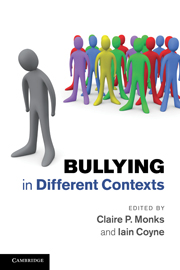Book contents
- Frontmatter
- Contents
- List of figures
- List of tables
- Notes on contributors
- 1 A history of research into bullying
- 2 Peer-victimisation in preschool
- 3 Bullying in schools: thirty years of research
- 4 Peer violence in residential children's homes: a unique experience
- 5 Domestic violence: bullying in the home
- 6 Juvenile dating and violence
- 7 Bullying in prisons: bringing research up to date
- 8 Bullying in the workplace
- 9 Elder abuse and bullying: exploring theoretical and empirical connections
- 10 Cyberbullying
- 11 An overview of bullying and abuse across settings
- Index
- References
10 - Cyberbullying
Published online by Cambridge University Press: 05 June 2012
- Frontmatter
- Contents
- List of figures
- List of tables
- Notes on contributors
- 1 A history of research into bullying
- 2 Peer-victimisation in preschool
- 3 Bullying in schools: thirty years of research
- 4 Peer violence in residential children's homes: a unique experience
- 5 Domestic violence: bullying in the home
- 6 Juvenile dating and violence
- 7 Bullying in prisons: bringing research up to date
- 8 Bullying in the workplace
- 9 Elder abuse and bullying: exploring theoretical and empirical connections
- 10 Cyberbullying
- 11 An overview of bullying and abuse across settings
- Index
- References
Summary
Since the mid 1990s developments in affordable personal computing and communication technology have resulted in the almost complete saturation of the household market in terms of internet connectivity and mobile telephone ownership. Most recent figures provided by the Office of Communications (Ofcom) indicate that, in the UK, while internet connectivity continues to rise, mobile telephony has almost reached saturation, with 73.5 million active subscriptions (1.25 subscriptions per head of the UK population; Ofcom, 2008). Within schools since 2002, it is estimated that 98 per cent of children and young people have had regular access to a computer (National Grid for Learning, 2002). As communication technologies have advanced and become a part of everyday life, the nature of social interaction has also changed. Where once a letter, memo or note, or a telephone call, would provide the means by which information was imparted with an expectation of a reply within a few days, today email, instant messaging and, of course, text messaging have become the norm, with the expectation of an immediate response. This is not only the way in which social interactions have changed among adults (both at home and in the workplace), it is also representative of the way children and young people now communicate with one another.
- Type
- Chapter
- Information
- Bullying in Different Contexts , pp. 211 - 230Publisher: Cambridge University PressPrint publication year: 2011
References
- 10
- Cited by



